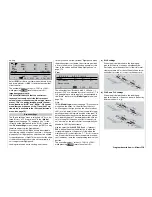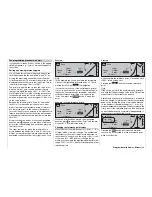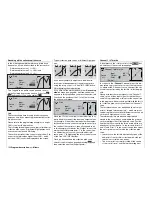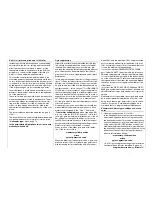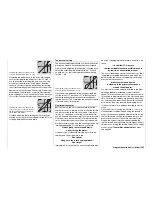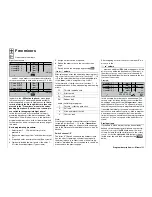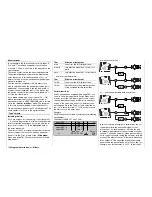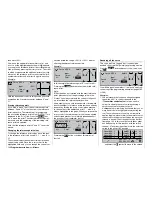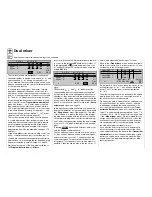
129
Program description:
Mixers
129
Although the throttle and collective pitch control sys-
tems are based on separate servos, they are always
operated in parallel by the throttle / collective pitch
stick (except when the auto-rotation fl ight phase is se-
lected). The Helicopter program automatically couples
the functions in the required way.
In the
mx
-24s program the trim lever of control func-
tion 1 acts only on the throttle servo. However, in the
»
Stick mode
« menu (see page 77) you can determi-
ne whether this should be used for idle trimming as
part of the throttle limit function, or for idle trimming
during the auto-rotation phase (“throttle AR”).
The process of adjusting throttle and collective pitch
correctly, i. e. setting the power curve of the motor to
match the collective pitch setting of the main rotor
blades, is the most important aspect of setting up any
model helicopter. The software of the
mx
-24s provi-
des independent adjustment facilities for the throttle,
collective pitch and tail rotor control curves in addition
to the C1 control curve (»
Channel 1 curve
« menu,
page 92), as already described.
It is certainly possible to set up curves with a maxi-
mum of eight points for these functions, but as a ge-
neral rule fewer points are suffi cient. We would always
advise that you start with three-point curves, as the
program provides them as standard on the second
screen page in each case. All you have to do to defi -
ne the control curves is adjust the centre setting “1”
and the two end-points (“L” (“low”) and “H” (“high”)) for
the throttle / collective pitch stick.
However, before you set up the throttle and collective
pitch function it is important to adjust the mechanical
linkages from all the servos accurately, in accordance
with the set-up instructions provided by the helicopter
manufacturer.
Note:
The hover point should normally be set to the
centre position of the throttle / collective pitch
Adjusting the throttle and collective pitch curves
A practical procedure
stick. However, for some special cases, e. g. for
“3-D” fl ying, you may wish to program hover
points which deviate from this norm, for examp-
le, one point for normal fl ying may be above the
centre, and one point for inverted fl ight below the
centre.
Idle setting and throttle curve
The idle setting is adjusted exclusively with the thrott-
le limiter closed, normally using the trim lever of the
C1 function, but in special cases using the throttle li-
miter (side-mounted proportional control) itself.
The bottom point “L” (low) setting of the throttle curve
defi nes the throttle setting when the helicopter is in a
descent, but without affecting the hover setting.
This is a case where you can exploit fl ight phase pro-
gramming to use different throttle curves – previous-
ly termed “idle-up” in earlier
mc
systems. This incre-
ased system rotational speed below the hover point
proves to be useful in certain circumstances, for ex-
ample for fast, steep landing approaches with greatly
reduced collective pitch, and for aerobatics.
Different throttle curves are programmed for each
fl ight phase, so that you can use the optimum set-up
both for hovering and aerobatics:
• Low system rotational speed with smooth, gentle
control response and low noise in the hover.
• Higher speed for aerobatics with motor power set-
tings close to maximum. In this case the throttle
curve also has to be adjusted in the hover range.
The diagram shows a three-point cur-
ve with a slightly altered throttle setting
below the reference point “1”. The cur-
ve has also been rounded off as descri-
bed earlier.
OUTPUT
–
+
L
H
Control travel
worst case the ball-links could even be forced out of
engagement.
The software of the
mx
-24s includes a function
which places a limit on the total swashplate travel, i. e.
it restricts the tilt angle of the swashplate from 100%
(the travel is limited to the value which would be ob-
tained with either roll of pitch-axis alone) to 149%
(no effective limit), or “off” (the function is completely
disabled). The swashplate limit is variable separately
for each model and each fl ight phase. (This software
solution is much more fl exible than a physical circular
surround attached to the stick unit; the latter can only
be used in any case if the roll and pitch-axis functions
are both controlled by one of the two dual-axis sticks.)
The sketch shown alongside
illustrates the effect of the limit
when it is set to 100%. The
travel range indicated by the
dotted lines is no longer ac-
tive, and takes the form of a
“dead zone”.
If this function is used, the
basic settings for “Dual Rate”
should be set to 100%, and Dual Rate values above
100% should not be used. If you set a swashplate li-
mit of 100% and use Dual Rates, swashplate move-
ment will be restricted even when roll and / or pitch-
axis commands are given separately.
Adjustment range: 100 … 149% and “off”.
Summary of Contents for mx-24s
Page 1: ...1...
Page 19: ...19 For your notes...
Page 35: ...35 For your notes...
Page 41: ...41 41 For your notes...
Page 57: ...57 For your notes...
Page 63: ...63 63 For your notes...
Page 69: ...69 69 For your notes...
Page 85: ...85 85 For your notes...
Page 99: ...99 For your notes...
Page 143: ...143 For your notes...
Page 191: ...191 For your notes...
Page 212: ...212 212 For your notes...
Page 213: ...213 213 For your notes...
Page 214: ...214 For your notes...
Page 216: ...216...





